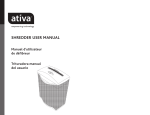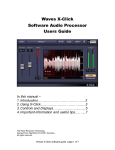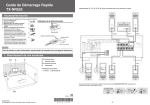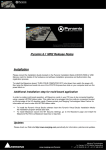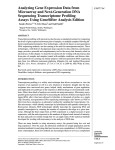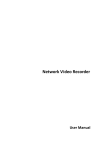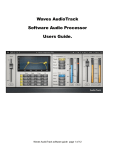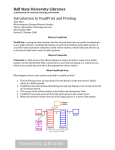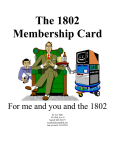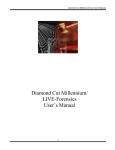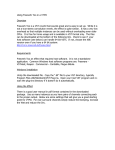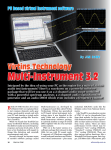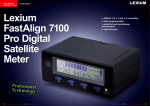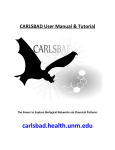Download here - TDL Tech
Transcript
original article | ron tipton Digital vs. Analog Equalization of Disc Record Playback Traditionally, analog networks were used for frequency emphasis during recording of other than acoustic records. It followed that analog networks be used for frequency deemphasis (equalization) during playback. The emphasis and de-emphasis networks complemented each other to produce an ideally flat frequency response. Most currently produced phonograph pre-amplifiers still use analog EQ. However, some individuals are saying that digital EQ is just as good – but is it? This study will hopefully help to answer this question. ____________________________________________________________________________________ I chose to do this comparison using the well-defined RIAA (Recording Industry Association of America)1 de-emphasis equalization (EQ) response. In keeping with conventional usage, I’ll refer to it as the RIAA playback response. But the comparison is also valid for any playback EQ that could be used for 78- or 45-rpm records. I will look at four cases: 1. Commercial 2/3-octave band and 1/3-octave band analog equalizers, 2. A commercial 1/3-octave band digital equalizer, 3. Several VST plug-ins running in a VST host (digital EQ), 4. The DC82 Virtual Phono Preamplifier and Parametric EQ (digital EQ). Baseline First, I need an analog baseline for the comparisons. The RIAA playback amplitude response is defined by several time-constants but these translate to amplitude-frequency pairs from 20 Hz to 21 kHz or higher. These values graph to a smooth curve as shown in Fig. 1. When an analog network is used, the phase response (Fig. 2a) as well as the time delay at each of the frequencies is also inherently defined. Fig. 2b (which intentionally has a linear frequency axis) shows the phase response is not linear3 so we can rule out EQ’s with a linear phase response. The RIAA time delay curve is not shown separately because it is included in each comparison graph. For this project I built a low-gain RIAA network: Fig. 3 shows the circuit diagram and its photo is in Photo 1. (This network matches the defined amplitude response within ±0.2 dB and has a correspondingly accurate phase and time delay responses.) ARSC Journal XLIII / ii 2012. © Association for Recorded Sound Collections 2012. All rights reserved. Printed in USA. 236 arsc Journal Figure 1: RIAA amplitude response measured on the baseline network. The measured values differ from the defined values by a maximum of +0.2 dB. Figure 2A: Measured phase response of the baseline RIAA network, log frequency axis. Figure 2B: Measured phase response of the baseline RIAA network with a linear frequency axis. The RIAA phase response is not linear. If it were, the phase response would be a straight line (see Reference 3). Digital vs. Analog Equalization of Disc Record Playback 237 2/3-Octave Band Analog EQ For this comparison I used a DOD model SR430Qx EQ,4 with the two mono channels in series to achieve the nearly 40 dB RIAA amplitude range. Using TrueRTA’s QuickSweep5 I first captured the amplitude response of my baseline network and saved it to the TrueRTA Workbench. Substituting the DOD EQ for the baseline network and using QuickSweep I adjusted the frequency band sliders to match the baseline curve. (This did take a while because I wanted a close match.) The result is shown in Fig. 4. The match is not too good at 20 kHz because a 2/3-octave band EQ has its highest frequency adjustment at a center frequency of 16 kHz. (I also did the match using pink noise but QuickSweep resulted in smoother curves.) The next step was to measure the phase response of the DOD EQ. For this I used a Dranetz model 305 phase meter mainframe with a 305-PA-3007 plug-in6 and a Tenma model 72-505 audio generator.7 The Tenma generator has 36 frequency steps from 20 Hz to 20 kHz and this simplifies repeated measurements because it’s much faster than using a continuously tuned generator and frequency counter. I recorded the phase readings with paper and pencil and then converted each value to time delay with a pocket calculator. The time delay is just the phase angle converted to time at each frequency. Td = q(1000) / 360 f Table 1: RIAA Baseline Circuit Parts List Symbol Value Description Vendor Part No. C1, C5 270nF 50V 5% V-series polyester* DigiKey P4668 C2, C6 15nF 50V 5% V-series polyester* DigiKey P4515 C3, C7 56nF 50V 5% V-series polyester** DigiKey P4522 C4, C8 22nF 50V 5% V-series polyester** DigiKey P4517 C9, C10, C11, C12 100nF 50V 5% V-series polyester DigiKey P4525 C13, C14 470 uF 16V 20% Radial electrolytic Mouser 647-UVR1E471MPD H1, H2, H3 3-pin header Mouser 538-22-03-2031 P1, P2, P3 3-pin terminal housing Mouser 538-22-01-2037 Molex terminals Mouser 538-08-50-0114 R1, R12 47K 1/4w 1% Metal film Mouser 271-47K-RC R2, R3, R4, R5, R6, R8, R9, R11, R13, R14, R15, R16, R17, R19, R20, R22 10K 1/4w 1% Metal film Mouser 271-10K-RC R7, R18 1100 1/4w 1% Metal film Mouser 271-1100-RC R10, R21 1000 1/4w 1% Metal film Mouser 271-1000-RC U1 TLC2274AIN Op-amp DigiKey 296-7123-5 U2 TLC2272IP Op-amp DigiKey 296-7117-5 Circuit board TDL M4041C.PCB * The C1 – C2 parallel capacitance selected to 285nF ±2% * The C5 – C6 parallel capacitance selected to 285nF ±2% ** The C3 – C4 parallel capacitance selected to 78nF ±2% ** The C7 – C8 parallel capacitance selected to 78nF ±2% 238 arsc Journal Figure 3: Low gain RIAA network for comparison baseline. Only one channel was used for this project. 1% resistors and matched capacitors produce a response that deviates no more than ±0.2 dB from the defined values. Photo 1: RIAA baseline circuit and power supply. (Any ±5 to ±8 VDC power supply can be used.) This low-gain circuit does not need shielding or low-noise opamps. Figure 4: RIAA baseline and DOD EQ amplitude comparison. The slightly wavy line is the DOD EQ response. Digital vs. Analog Equalization of Disc Record Playback 239 Figure 5: Time delay comparison of the baseline RIAA network with a DOD SR430Qx EQ adjusted to the RIAA amplitude response using QuickSweep in TrueRTA. Figure 6: Equalizer test setup for listening and recording. The model 4010 is set to flat Turnover and flat Rolloff. Mode switch to L+R. Rumble filter to 20 Hz and HF Filter to 24 kHz. ____________________________________________________________________________________________ Where Td is time delay in milliseconds, q is the phase angle in degrees and f is the frequency in Hz. Please note that both axes (Fig. 5) are logarithmic – but so is the amplitude response in Fig. 4. Although the amplitude response is linear in dB, the Decibel is a logarithmic unit. I like the clarity of comparing time delays rather than phase but both are equally accurate. The match in Fig. 5 is not too bad so I decided on a listening test. I played a selection of tracks from early LP records first with just a TDL model 4010 pre-amp8 set to RIAA equalization and then with the 4010 set for flat equalization into the DOD EQ set to RIAA. This setup is shown in Fig. 6. (The DOD EQ needs the gain of a phono pre-amp to produce a useful output signal level.) The RIAA EQ network in the model 4010 is identical to the baseline network except the baseline network has much lower gain. In addition to listening, I recorded both EQ versions on the computer hard-drive at 96 kHz sample rate and 24 bit depth so I could send a comparison DVD to other listeners who may have a higher musical acuity than I do. Tracks 1 and 3 are from the DOD EQ and tracks 2 and 4 are from the model 4010 pre-amp. 240 arsc Journal Figure 7: RIAA baseline and dbx231 EQ amplitude comparison. The wavy line has more “waves” from this 31-band EQ than from the 15-band DOD EQ. Figure 8: Time delay comparison: RIAA network to dbx231 EQ. The dbx EQ does not have as good a fit to the RIAA curve as does the DOD equalizer. Figure 9: RIAA baseline and DEQ1024 EQ amplitude comparison. The match using this digital equalizer is very good in the 20 Hz to 2500 Hz range. Another DEQ1024 would be needed in series for comparison up to 20 kHz. Digital vs. Analog Equalization of Disc Record Playback 241 One listener commented as follows: “I first listened using my office computer’s onboard Realtek sound chip and the tiny speakers in my monitor. I figured if I could hear a difference with a lo-fi rig it would be pretty telling. The difference was pretty clear to me. Tracks 1 and 3 sounded dull and lifeless, tracks 2 and 4 sounded like real instruments. The differences were even more telling when I listened in my music room; most notably in the area of bass definition. All-in-all, I would describe the sound of tracks 2 and 4 as more coherent. This is apparent as a more natural sound for each instrument, ease of distinguishing between instruments, and a greater sense of ambiance.” Other listener comments followed suit: the DOD EQ does not make the grade as a useful RIAA playback equalizer. 1/3-Octave Band Analog EQ I used a dbx model 231S. The ±12 dB range of each slider does not cover the RIAA amplitude range so I used the two mono channels in series. I imported the RIAA amplitude curve onto the TrueRTA Workbench and then, using QuickSweep, began adjusting the sliders to match the RIAA curve. With 62 frequency sliders this took an hour or more. Fig. 7 shows the results; the ripples in the dbx response pretty well correspond to the filter center frequencies. The time delay comparison in Fig. 8 shows a poorer match than the DOD EQ even though the frequency response match was as good if not better. This supports the “rule of thumb” that the least amount of EQ to do the job is best. 9 1/3-Octave Band Digital EQ A Behringer model DEQ10249 was pressed into service for this comparison. I think the procedure has been sufficiently well described so I will just present the results. The amplitude match (Fig. 9) is quite good in the 20 Hz to about 2500 Hz range. With just one DEQ1024 I didn’t have enough amplitude adjustment range to go to higher frequencies. The time delay comparison (Fig. 10) shows no match at all. This digital EQ is not at all suitable for trying to match the RIAA phase response. Those who recommend using a phono pre-amp with a flat response and then correcting the file with a digital EQ would not get good sound with the DEQ1024. VST EQ Plug-Ins Virtual Studio Technology was developed by Steinberg GmbH11 to add modular virtual instruments and effects (such as EQ) to their Cubase digital audio workstation (DAW) software. By using a real-time host, a VST plug-in (such as an EQ) becomes a virtual EQ with its inputs and outputs being the sound card inputs and outputs. Measurements can be made on the virtual EQ just as if it were a hardware EQ. There are many real-time VST hosts available: some free, some rather pricey and some “in between.” I have evaluated several with four useful products listed here: 1. Minihost12 is donationware, it’s small in size and very easy to use. Its disadvantage is not being able to load more than one VST plug-in at a time. That is, you can’t load two instances of an EQ to achieve the 40 dB RIAA amplitude range. 242 arsc Journal Figure 10: Comparison of the RIAA time delay to a Behringer DEQ1024 digital equalizer within the frequency band where there is a good match between the amplitude responses. Figure 11: RIAA baseline and Anwidasoft GEQ31V 31-band VST EQ amplitude response comparison using TrueRTA QuickSweep. Two series instances of this EQ were setup in Cantabile to cover the 40 dB amplitude range. The GEQ31V has a digital readout to set the boost or cut for each frequency band. Figure 12: Amplitude response of the KarmaFX VST EQ using QuickSweep. All frequency band sliders were set to 0 dB (a flat line). This EQ has an amplitude range of ±12 dB. Digital vs. Analog Equalization of Disc Record Playback 243 2. Cantabile Solo 2.013 has a reasonable license fee and I think it’s well worth it. It comes with a pdf format User Guide but using it is largely intuitive. Very powerful and will load several plug-ins at the same time. 3. Cubase LE 414 is a full-featured DAW and is “over kill” for this project. However, this older version is very reasonably priced and it can be activated online for free. 4. REAPER version 415 is also a full-featured DAW: it has a 398-page printed User Guide (for an additional charge) and a low license fee. I used at least two host programs (mostly Minihost and Cantabile) for all plug-in measurements as a “sanity” check. It’s important to be able to repeat results! After making measurements with several different plug-ins, it became apparent that the amplitude response could not be made to match the RIAA curve, Fig. 11. So I decided to try a “flat line” at 0dB to find out how much of a match is possible. Fig. 12 shows the result of setting up this test on KarmaFX16 running in Cantabile. A second computer is needed to supply a signal to the plug-in’s input. In this case, I used TrueRTA to generate both QuickSweep and pink noise. The output is not a flat line and this shows why trying to match a smooth curve with QuickSweep or pink noise will not work. (A manual slow-sweep using a continuously tuneable audio generator and output voltmeter produced the same result.) I tried this on several of the other VST EQ plug-ins with much the same outcome.17 In all the VST plug-in tests the input and output voltage levels were kept well below the clipping level of both the software and the sound card. The procedure for running the above tests in Cantabile is as follows: Use a second computer with its sound card output connected to the Cantabile sound card input, and launch TrueRTA, Launch Cantabile and load an EQ plug-in, Click the Cantabile Record drop-down menu to setup the recording choices, Click the Cantabile Record button, Click the TrueRTA QuickSweep button (or choose pink noise and click GO). I did find one exception. The Algorithmix18 LinearPhase PEQ Red produced a nearly flat line with QuickSweep, Fig. 13, when all ten filters were set to 0dB. But this is a linear phase EQ so its phase response would be incorrect even with a perfect amplitude match. Also, its license fee of 999 Euros puts it out of my reach for experimentation. Virtual Phono Preamplifier in DC8 This built-in DC82 feature is basically a “re-equalizer” because it will accept an RIAA or flat input and output an RIAA or one of several “older record” equalizations. I chose 244 arsc Journal Figure 13: PEQ Red output with TrueRTA QuickSweep and pink noise inputs. All ten EQ filters were set to 0 dB gain and to the same Q (bandwidth) value. Figure 14: Amplitude response difference between the DC8 Virtual Phono Preamplifier and the calculated RIAA response. The DC8 VPP was set to Flat input and RIAA output with the Tone Controls disabled. Figure 15: RIAA time delay (upper curve) compared to the DC8 VPP set to Flat input and RIAA output with the Tone Controls disabled. Digital vs. Analog Equalization of Disc Record Playback 245 to test the VPP with a flat input and an RIAA output. User setup is simple. In addition to radio-buttons for in and out selection it has check boxes for Tone Controls enabled or disabled and a 30 Hz Rumble Filter that can be turned on or off. And there are sliders for Left-Right Balance and Volume. I recorded the same tracks used in the DOD EQ tests with the model 4010 preamp set to L+R, flat turnover and flat rolloff, 20 Hz Rumble Filter and HF Filter set to 24 kHz. I used the resulting files as the input to the VPP and recorded the output files which I sent to listeners for comments. While waiting for comments, I made amplitude and time delay measurements on the VPP. I created an input file of 36 frequency bands from 20 Hz to 20 kHz (the same frequencies produced by the Tenma audio generator) for compatibility with previous measurements. Each band is 20 seconds in length and separated by 4 seconds of silence from the next band and all bands have the same amplitude so it’s a “flat” recording. With the VPP set to RIAA output I recorded the equalized file. Playing the output file into an RMS voltmeter produced the values used in the Fig. 14 comparison graph. The maximum deviation is -0.33 dB at 28 Hz. The negative sign indicates the measured VPP values were lower than the calculated RIAA values. The procedure for running this test is as follows: Launch VPP in DC8 and setup the user parameters as mentioned above (Tone Controls disabled, Rumble Filter on, Left-Right Balance centered and Volume to maximum), Open the source file, in this case tones.wav, In DC8 click Record and setup the sample rate and bit resolution, In the VPP window click Run Filter, When the filter has finished running, click Files in DC8, click Save Destination As and give the output file a name. I then made a composite stereo file with the left track the 36 equal amplitude frequency bands and the right track the VPP output. Using this file as the reference and signal inputs to the phase meter I recorded and graphed Fig. 15 comparing the measured time delay to the RIAA delay. Although not identical, the curves are very close. (Even with a 96 kHz sampling rate there are some issues in making accurate time delay measurements at the higher audio frequencies: only 4.8 samples per cycle at 20 kHz.) My primary reviewer commented as follows on the VPP equalizations: “I didn’t have a clear preference with the Pachelbel but I did with the Atkins. To my ears the VPP version had better instrument definition with clearer sound at all frequencies. The guitar sounded more like a real guitar while the 4010 version sounded slightly 246 arsc Journal Figure 16: Screen shot of the DC8 Paragraphic EQ using the RIAA Phono Preamp Improved preset. Figure 17: Comparison of the RIAA amplitude response to the DC8 Paragraphic EQ set to RIAA “Improved.” veiled. The VPP and 4010 versions are very close, and with different music choices I might slightly favor either one. At times, for example, I thought that the 4010 had a somewhat warmer sound on the Pachelbel.” Paragraphic EQ in DC8 The Paragraphic EQ is in the Filters pull-down menu. It has several presets and one of them is RIAA Phono Equalizer – Improved. When this is selected, we get the screen shown in Fig. 16. The amplitude measurement procedure was the same as for the DC8 VPP with the RIAA comparison shown in Fig. 17. The match is not very good so I did not bother to make time delay measurements. Sony Sound Forge19 has a Paragraphic EQ but it has only four “peak” type filters each with a maximum bandwidth of 2.5 octaves so there is no way to match the RIAA curve. Digital vs. Analog Equalization of Disc Record Playback 247 Discussion This has been an interesting and sometimes frustrating project with the following conclusions. General-purpose hardware analog EQ’s are not useful for RIAA playback. And at this time, there seems to be only one digital RIAA EQ that’s useful: the Virtual Phono Preamplifier (VPP) in DC8. My thanks to Don Walizer for being the “primary” music reviewer. He listened to quite a few different DVD versions of Side 1 of Chet Atkin’s Solo Flights (RCA Victor LSP-3922) and Johann Pachelbel’s Canon in D Major (Musical Heritage Society MHS-1060). Others have recognized the importance of proper playback phase response when using digital EQ. For example, Gary Galo investigated this topic in a paper for the ARSC Journal 20 . He too found the VPP in DC versions 6 and 7 had the correct phase response (version 8 was not available at that time). He found that correct phase response could be achieved with IIR digital filters but not with FIR 21 filters which are still commonly used in digital EQ software, and apparently also in digital EQ hardware. Some manufacturers were unable to tell him which type of filter was in use in their products so this is another case of using an item that has been proven to function correctly, or else evaluating it yourself. Ron Tipton is president and principal designer at TDL Technology, Inc. (Las Cruces, NM), an electronics design and manufacturing company he started in 1957. He has degrees in electrical engineering from New Mexico State University and he is retired from a design engineering position at White Sands Missile Range. Ron has designed and built equipment for companies including Bose and Acoustic Research and worked as a consultant to GMS, Inc. (Prairie Grove, AR) designing guitar amplifiers and effects modules for Gretsch. He has authored contributions to a number of specialist publications, among them audioXpress, Voice Coil, Multi Media Manufacturing, Poptronics, Nuts & Volts Magazine and Circuit Cellar. __________________________________________________________________________________ Endnotes 1. The Recording Industry Association of America (RIAA) has defined a recording and playback standard for vinyl records produced since 1954. A table of frequency vs. gain (or attenuation) values can be found in many places. For example: http://www.bonavolta.ch/ hobby/en/audio/riaa.html 2.DC8 is the name of an audio editor and record restoration program from Diamond Cut Productions (version 8). It is available from http://www.diamondcut.com and from http:// www.tracertek.com. 3. Linear phase is defined as: the property of a filter where the phase response is a linear function of frequency. That is, the phase response is a straight line when both phase and frequency are plotted on linear axes. 4. DOD is a manufacturer of hardware graphic equalizers and other audio processors. Product information is available from http://www.dod. com. 5.TrueRTA is a spectrum analysis program available from TrueAudio: http://www.trueaudio.com. All testing in this article using TrueRTA was done with the level 4 version. Demo versions and a free version (level 1) are available from their web site. 6. This phase meter features automatic frequency and input level ranging which greatly simplifies making measurements. This model is not in current production but pre-owned units may be found on ebay and from used electronic test instrument distributors. 248 arsc Journal 7. The Tenma 72-505 Audio Generator is available from MCM Electronics: http://www.mcmelectronics.com. 8. The TDL model 4010 Phono pre-amplifier data and user guide (pdf format) can be found at http://www.tdl-tech.com/data4010.htm. 9. dbx Professional Products manufactures hardware graphic equalizers and other audio processing equipment. Product information at: http://www.dbxpro.com. 10. Behringer manufacturers a wide range of audio products including analog and digital graphic equalizers: http://www.behringer.com. 11. Steinberg GmbH manufacturers audio hardware and software: http://www.steinberg.com. 12. Minihost is a free VST plug-in host with full ASIO support. Although the download is free, a donation is appreciated if you use it regularly. Information and download from: http:// www.tobybear.de/p_minihost.html 13.Cantabile is a VST plug-in host, professional and personal (Solo) versions, from TopTen Software. A free trial version is available and the Solo version registration fee is reasonable. http://www.cantabilesoftware.com. 14.Cubase is a product of Steinberg GmbH: see number 11 above. 15.Reaper is a full-featured Digital Audio Workstation (DAW). It performs as well or better than DAWs costing many times its registration fee: http://www.reaper.fm. 16.KarmaFX is a 31-band VST EQ. It’s free but a donation is appreciated from frequent users. Unlike many free programs, it has a useful User’s Manual. Pdf Manual and download from: http://www.karmafx.net. 17. Many VST EQs are available online. Some are free and some have a license fee (usually after a free trial period). Use your favorite search engine to look for VST EQ plug-ins. 18. LinearPhase PEQ Red is a VST EQ plug-in from Algorithmix GmbH. You can visit their web site for product information and to request a link to download a trial version and the Operator’s Manual (a pdf file). http://www. algorithmix.com. 19. Sony Sound Forge, version 10 is an audio recording and editing program available from http://www.sonycreativesoftware.com and from many audio software distributors. 20. Galo, Gary A. “Phase Equalization and its Importance in the Reproduction of Disc Records” in ARSC Journal, 2010;41(1):83-96. 21. IIR (Infinite Impulse Response) and FIR (Finite Impulse Response) digital filter theory is beyond the scope of this paper but many texts are available. For example, see Williams, Arthur B. and Fred J. Taylor Electronic Filter Design Handbook, McGrawHill, Inc., Second Edition 1988.














